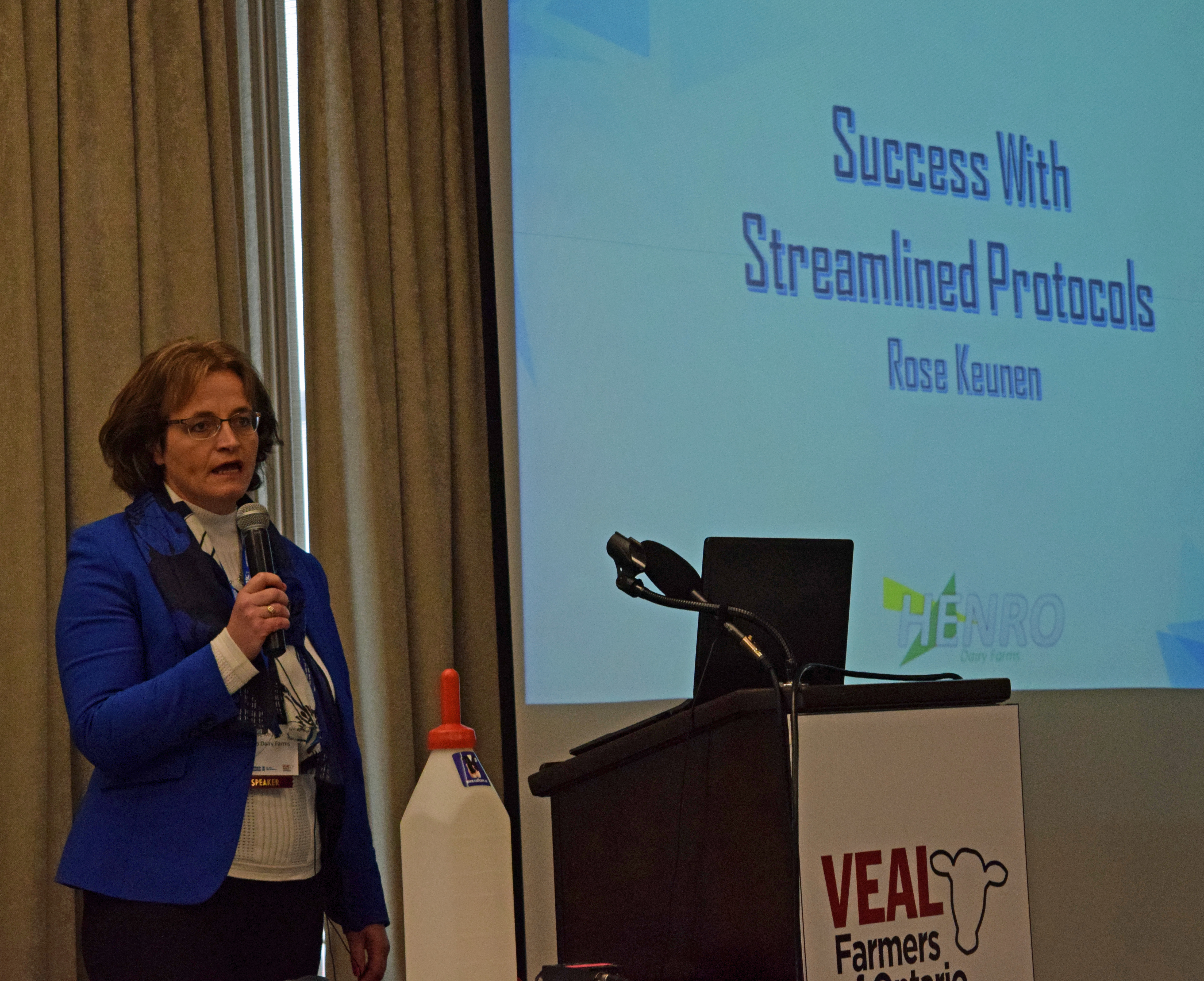Rose and Henry Keunen are award-winning southwestern Ontario dairy farmers. Their innovative approach to problem-solving and their attention to even the smallest details are keys to their success, particularly when it comes to calf feeding.

Rose Keunen
Rose Keunen shared Henro Dairy Farms’ calf feeding secrets with participants at the Building the Foundation 2016 Dairy and Veal Healthy Calf Conference, providing insight into how they achieve and maintain a consistently low mortality rate.
The conference was funded in part through Growing Forward 2 (GF2), a federal-provincial-territorial initiative. The Agricultural Adaptation Council assists in the delivery of GF2 in Ontario.
For the first 10 months of 2016, the Henro mortality rate of calves from birth to four months of age averaged 2.03 per cent, which translates into nine deaths out of 443 calves born.
Gathering detailed death loss data is key in getting a farm’s mortality rate under control, Rose stated.
“Data should be a true measure of your barn performance. Record why they die so you can analyze and figure out what to do, whether it’s your facility, your protocols etc.,” she explained. “There is a lot of information that comes back if you record data and death loss.”
The Keunens house their calves in single and group hutches in a 200 by 60 foot Calhoun structure that protects them from sun, rain and snow and provides a comfortable work environment for their employees. They work with an all-in, all-out system and both single and group hutches are bedded with straw and top-dressed with sawdust.
“We have six people involved with feeding calves and we feed three times daily,” Rose said. “Sometimes workers will come in that haven’t seen a calf in a week, but we still have low mortality rates.”
And that’s a success Rose attributes to the Keunens’ protocol system. She personally trains every worker regardless of their experience when they start their employment on the farm, believing this reduces the possibility of bad habits being passed from one employee to the next. She also likes to monitor new employees for quite a while because although feeding itself is not a complex task, it can be difficult to recognize early stage health issues before a calf gets sick.
“Have all your protocols written down on one sheet that has the most important things on it that stays in the barn,” she advised. “Nobody will look at detailed binders, so one page in the barn is important. Keep it simple and consistent.”
Written feedback from workers is also a critical part of the Keunen success formula. By recording everything on the protocol sheet, any worker can feed any calf on the farm at any time without having to talk to someone – and important observations and information don’t miss being passed on.
During the daily feedings, workers keep track of how many calves are fed colostrum and regular milk, how much each calf consumes, and which calves might need a bit of extra help, such as getting to the bottle holder.
During feeding, workers walk among the hutches and observe the animals. Anything abnormal – such as not finishing a whole bottle of milk, playing with the nipple instead of drinking, or lying down at feeding time – is recorded on the protocol sheet and the calf is immediately started on electrolytes.
It’s important to catch calves before they get sick, according to Rose, who explained that if they can get a calf onto electrolytes on its first day off the bottle, nine times out of 10 that animal won’t get diarrhea. And if it does, it’s usually a much lighter case that it would otherwise have been.
Regular milk fed to the calves is pasteurized in a specially-designed pasteurizer that has an integrated bottle washer for easy cleaning and disinfecting of the bottles after use. Milk is heated to 67°C, where it is held for 30 minutes, and then cools to 40°C at which point it is filled into bottles. By the time the bottles are in front of the calves, the milk has reached its serving temperature of 38°C.
Partial weaning is started when calves are still in their individual hutches, and continues slowly once they’re moved to group hutches. The Keunens’ complete weaning process takes two and a half to three weeks, and is based on pellet intake as opposed to age.
“Weaning is an extremely slow process. We do one change at a time or else you put too many stress factors on a calf,” Rose explained. “A calf has to eat two kilograms of pellets a day for seven days in a row to be taken off completely.”
In the winter, calf blankets are used to help reduce heat loss. Water and pellets are changed daily and calves receive warm water during the cold months, which helps insulate them against the cold and stimulates pellet intake. They’re given dry bedding all the time, along with top quality hay, and careful attention is paid to fly control.
A printable copy of the chart template developed by the Keunens is available here.
